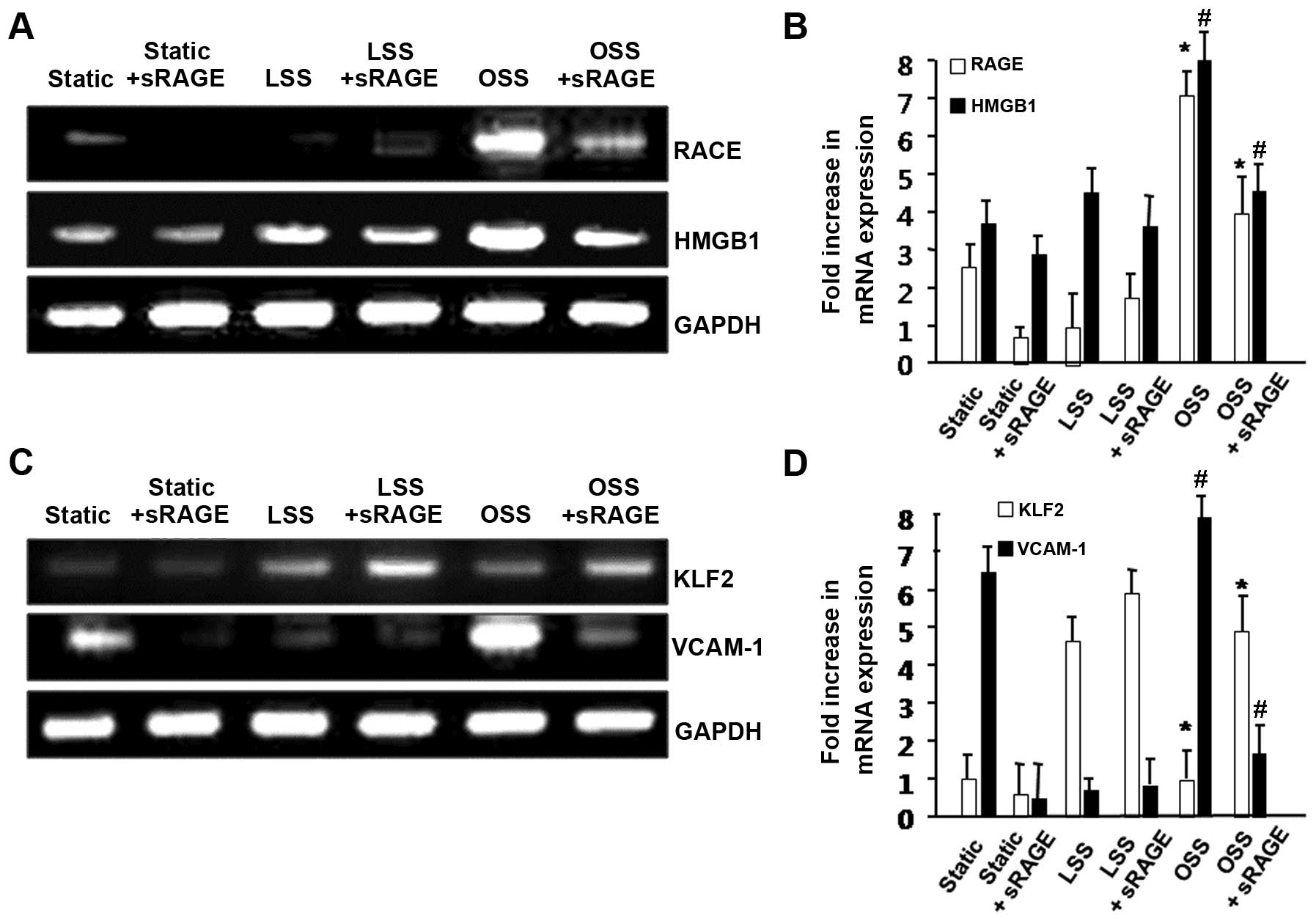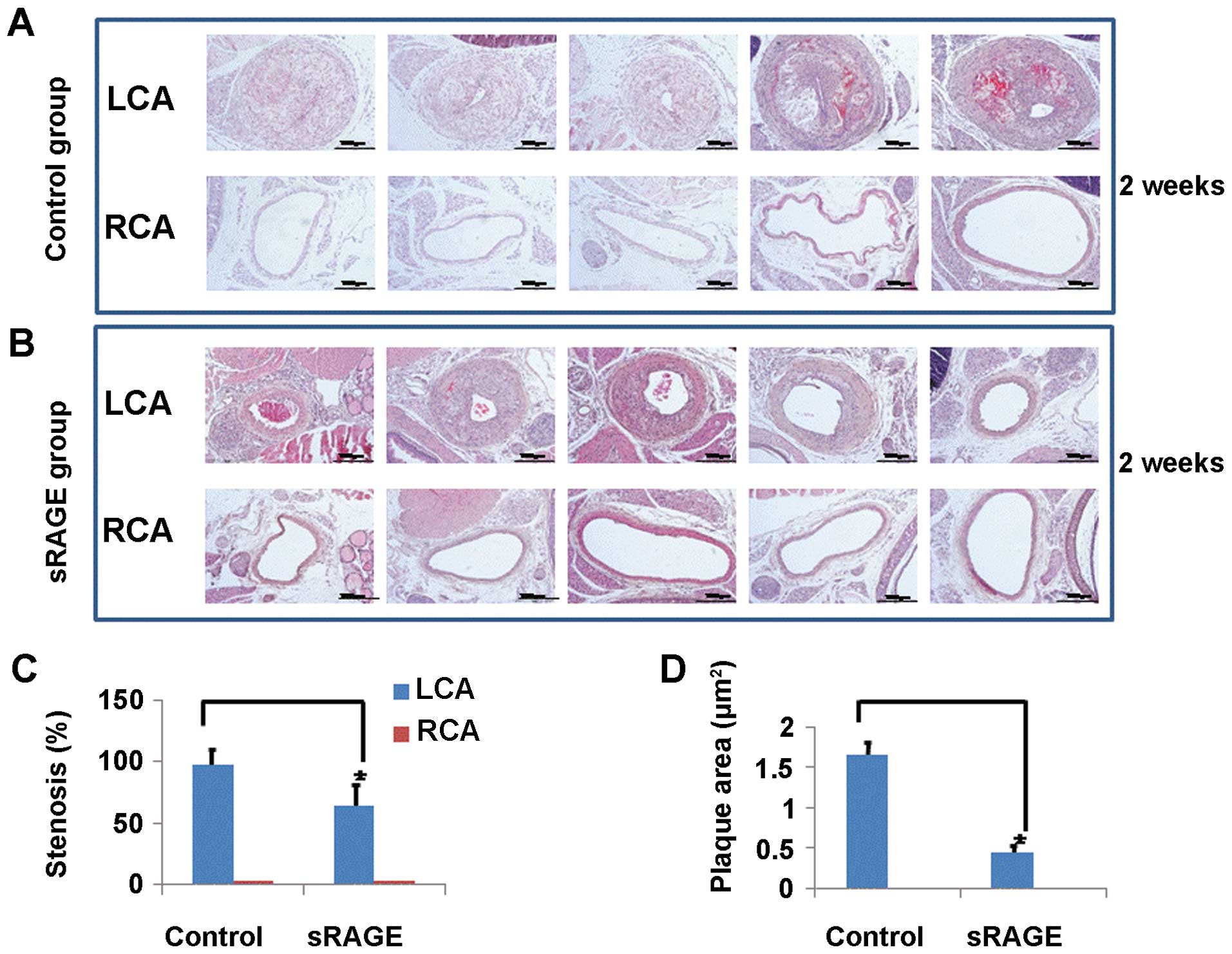|
1
|
Ross R: Atherosclerosis - an inflammatory
disease. N Engl J Med. 340:115–126. 1999. View Article : Google Scholar
|
|
2
|
Chiu JJ, Usami S and Chien S: Vascular
endothelial responses to altered shear stress: pathologic
implications for atherosclerosis. Ann Med. 41:19–28. 2009.
View Article : Google Scholar : PubMed/NCBI
|
|
3
|
Chiu JJ and Chien S: Effects of disturbed
flow on vascular endothelium: pathophysiological basis and clinical
perspectives. Physiol Rev. 91:327–387. 2011. View Article : Google Scholar : PubMed/NCBI
|
|
4
|
Nam D, Ni CW, Rezvan A, Suo J, Budzyn K,
Lianos A, Harrison D, Giddens D and Jo H: Partial carotid ligation
is a model of acutely induced disturbed flow, leading to rapid
endothelial dysfunction and atherosclerosis. Am J Physiol Heart
Circ Physiol. 297:H1535–H1543. 2009. View Article : Google Scholar : PubMed/NCBI
|
|
5
|
DeVerse JS, Bailey KA, Jackson KN and
Passerini AG: Shear stress modulates RAGE-mediated inflammation in
a model of diabetes-induced metabolic stress. Am J Physiol Heart
Circ Physiol. 302:H2498–H2508. 2012. View Article : Google Scholar : PubMed/NCBI
|
|
6
|
Lindsey JB, Cipollone F, Abdullah SM and
McGuire DK: Receptor for advanced glycation end-products (RAGE) and
soluble RAGE (sRAGE): cardiovascular implications. Diab Vasc Dis
Res. 6:7–14. 2009. View Article : Google Scholar : PubMed/NCBI
|
|
7
|
Harja E, Bu DX, Hudson BI, Chang JS, Shen
X, Hallam K, Kalea AZ, Lu Y, Rosario RH, Oruganti S, Nikolla Z,
Belov D, Lalla E, Ramasamy R, Yan SF and Schmidt AM: Vascular and
inflammatory stresses mediate atherosclerosis via RAGE and its
ligands in apoE−/− mice. J Clin Invest. 118:183–194.
2008. View
Article : Google Scholar : PubMed/NCBI
|
|
8
|
Schlueter C, Hauke S, Flohr AM, Rogalla P
and Bullerdiek J: Tissue-specific expression patterns of the RAGE
receptor and its soluble forms - a result of regulated alternative
splicing? Biochim Biophys Acta. 1630:1–6. 2003. View Article : Google Scholar : PubMed/NCBI
|
|
9
|
Herold K, Moser B, Chen Y, Zeng S, Yan SF,
Ramasamy R, Emond J, Clynes R and Schmidt AM: Receptor for advanced
glycation end products (RAGE) in a dash to the rescue: inflammatory
signals gone awry in the primal response to stress. J Leukoc Biol.
82:204–212. 2007. View Article : Google Scholar : PubMed/NCBI
|
|
10
|
Park L, Raman KG, Lee KJ, Lu Y, Ferran LJ
Jr, Chow WS, Stern D and Schmidt AM: Suppression of accelerated
diabetic atherosclerosis by the soluble receptor for advanced
glycation endproducts. Nat Med. 4:1025–1031. 1998. View Article : Google Scholar : PubMed/NCBI
|
|
11
|
Bucciarelli LG, Wendt T, Qu W, Lu Y, Lalla
E, Rong LL, Goova MT, Moser B, Kislinger T, Lee DC, Kashyap Y,
Stern DM and Schmidt AM: RAGE blockade stabilizes established
atherosclerosis in diabetic apolipoprotein E-null mice.
Circulation. 106:2827–2835. 2002. View Article : Google Scholar : PubMed/NCBI
|
|
12
|
Zhou Z, Wang K, Penn MS, Marso SP, Lauer
MA, Forudi F, Zhou X, Qu W, Lu Y, Stern DM, Schmidt AM, Lincoff AM
and Topol EJ: Receptor for AGE (RAGE) mediates neointimal formation
in response to arterial injury. Circulation. 107:2238–2243. 2003.
View Article : Google Scholar : PubMed/NCBI
|
|
13
|
Ha CH, Wang W, Jhun BS, Wong C, Hausser A,
Pfizenmaier K, McKinsey TA, Olson EN and Jin ZG: Protein kinase
D-dependent phosphorylation and nuclear export of histone
deacetylase 5 mediates vascular endothelial growth factor-induced
gene expression and angiogenesis. J Biol Chem. 283:14590–14599.
2008. View Article : Google Scholar
|
|
14
|
Jin ZG, Ueba H, Tanimoto T, Lungu AO,
Frame MD and Berk BC: Ligand-independent activation of vascular
endothelial growth factor receptor 2 by fluid shear stress
regulates activation of endothelial nitric oxide synthase. Circ
Res. 93:354–363. 2003. View Article : Google Scholar
|
|
15
|
Dave SH, Tilstra JS, Matsuoka K, Li F,
DeMarco RA, Beer-Stolz D, Sepulveda AR, Fink MP, Lotze MT and Plevy
SE: Ethyl pyruvate decreases HMGB1 release and ameliorates murine
colitis. J Leukoc Biol. 86:633–643. 2009. View Article : Google Scholar : PubMed/NCBI
|
|
16
|
Sasaki T, Kuzuya M, Cheng XW, Nakamura K,
Tamaya-Mori N, Maeda K, Kanda S, Koike T, Sato K and Iguchi A: A
novel model of occlusive thrombus formation in mice. Lab Invest.
84:1526–1532. 2004. View Article : Google Scholar : PubMed/NCBI
|
|
17
|
Zhou J, Lhotak S, Hilditch BA and Austin
RC: Activation of the unfolded protein response occurs at all
stages of atherosclerotic lesion development in apolipoprotein
E-deficient mice. Circulation. 111:1814–1821. 2005. View Article : Google Scholar : PubMed/NCBI
|
|
18
|
Berk BC: Atheroprotective signaling
mechanisms activated by steady laminar flow in endothelial cells.
Circulation. 117:1082–1089. 2008. View Article : Google Scholar : PubMed/NCBI
|
|
19
|
Davies PF: Flow-mediated endothelial
mechanotransduction. Physiol Rev. 75:519–560. 1995.PubMed/NCBI
|
|
20
|
Gimbrone MA Jr, Topper JN, Nagel T,
Anderson KR and Garcia-Cardena G: Endothelial dysfunction,
hemodynamic forces, and atherogenesis. Ann NY Acad Sci.
902:230–240. 2000. View Article : Google Scholar : PubMed/NCBI
|
|
21
|
Boo YC and Jo H: Flow-dependent regulation
of endothelial nitric oxide synthase: role of protein kinases. Am J
Physiol Cell Physiol. 285:C499–C508. 2003. View Article : Google Scholar : PubMed/NCBI
|
|
22
|
Chien S: Mechanotransduction and
endothelial cell homeostasis: the wisdom of the cell. Am J Physiol
Heart Circ Physiol. 292:H1209–H1224. 2007. View Article : Google Scholar : PubMed/NCBI
|
|
23
|
Shyy YJ, Hsieh HJ, Usami S and Chien S:
Fluid shear stress induces a biphasic response of human monocyte
chemotactic protein 1 gene expression in vascular endothelium. Proc
Natl Acad Sci USA. 91:4678–4682. 1994. View Article : Google Scholar : PubMed/NCBI
|
|
24
|
Kraiss LW, Geary RL, Mattsson EJ, Vergel
S, Au YP and Clowes AW: Acute reductions in blood flow and shear
stress induce platelet-derived growth factor-A expression in baboon
prosthetic grafts. Circ Res. 79:45–53. 1996. View Article : Google Scholar : PubMed/NCBI
|
|
25
|
Wilcox JN, Smith KM, Williams LT, Schwartz
SM and Gordon D: Platelet-derived growth factor mRNA detection in
human atherosclerotic plaques by in situ hybridization. J Clin
Invest. 82:1134–1143. 1988. View Article : Google Scholar : PubMed/NCBI
|
|
26
|
SenBanerjee S, Lin Z, Atkins GB, Greif DM,
Rao RM, Kumar A, Feinberg MW, Chen Z, Simon DI, Luscinskas FW,
Michel TM, Gimbrone MA Jr, Garcia-Cardena G and Jain MK: KLF2 is a
novel transcriptional regulator of endothelial proinflammatory
activation. J Exp Med. 199:1305–1315. 2004. View Article : Google Scholar : PubMed/NCBI
|
|
27
|
Parmar KM, Larman HB, Dai G, Zhang Y, Wang
ET, Moorthy SN, Kratz JR, Lin Z, Jain MK, Gimbrone MA Jr and
Garcia-Cardena G: Integration of flow-dependent endothelial
phenotypes by Kruppel-like factor 2. J Clin Invest. 116:49–58.
2006. View
Article : Google Scholar : PubMed/NCBI
|
|
28
|
Lee JS, Yu Q, Shin JT, Sebzda E, Bertozzi
C, Chen M, Mericko P, Stadtfeld M, Zhou D, Cheng L, Graf T, MacRae
CA, Lepore JJ, Lo CW and Kahn ML: Klf2 is an essential regulator of
vascular hemodynamic forces in vivo. Dev Cell. 11:845–857. 2006.
View Article : Google Scholar : PubMed/NCBI
|
|
29
|
Atkins GB and Jain MK: Role of
Kruppel-like transcription factors in endothelial biology. Circ
Res. 100:1686–1695. 2007. View Article : Google Scholar : PubMed/NCBI
|
|
30
|
Dekker RJ, van Soest S, Fontijn RD,
Salamanca S, de Groot PG, VanBavel E, Pannekoek H and Horrevoets
AJ: Prolonged fluid shear stress induces a distinct set of
endothelial cell genes, most specifically lung Kruppel-like factor
(KLF2). Blood. 100:1689–1698. 2002. View Article : Google Scholar : PubMed/NCBI
|
|
31
|
Tsao PS, Buitrago R, Chan JR and Cooke JP:
Fluid flow inhibits endothelial adhesiveness. Nitric oxide and
transcriptional regulation of VCAM-1. Circulation. 94:1682–1689.
1996. View Article : Google Scholar : PubMed/NCBI
|
|
32
|
Fledderus JO, van Thienen JV, Boon RA,
Dekker RJ, Rohlena J, Volger OL, Bijnens AP, Daemen MJ, Kuiper J,
van Berkel TJ, Pannekoek H and Horrevoets AJ: Prolonged shear
stress and KLF2 suppress constitutive proinflammatory transcription
through inhibition of ATF2. Blood. 109:4249–4257. 2007. View Article : Google Scholar : PubMed/NCBI
|
|
33
|
Passerini AG, Polacek DC, Shi C, Francesco
NM, Manduchi E, Grant GR, Pritchard WF, Powell S, Chang GY,
Stoeckert CJ Jr and Davies PF: Coexisting proinflammatory and
antioxidative endothelial transcription profiles in a disturbed
flow region of the adult porcine aorta. Proc Natl Acad Sci USA.
101:2482–2487. 2004. View Article : Google Scholar : PubMed/NCBI
|
|
34
|
Berk BC, Abe JI, Min W, Surapisitchat J
and Yan C: Endothelial atheroprotective and anti-inflammatory
mechanisms. Ann NY Acad Sci. 947:93–111. 2001. View Article : Google Scholar : PubMed/NCBI
|
|
35
|
Mullins GE, Sunden-Cullberg J, Johansson
AS, Rouhiainen A, Erlandsson-Harris H, Yang H, Tracey KJ, Rauvala
H, Palmblad J, Andersson J and Treutiger CJ: Activation of human
umbilical vein endothelial cells leads to relocation and release of
high-mobility group box chromosomal protein 1. Scand J Immunol.
60:566–573. 2004. View Article : Google Scholar : PubMed/NCBI
|
|
36
|
Frommhold D, Kamphues A, Hepper I,
Pruenster M, Lukic IK, Socher I, Zablotskaya V, Buschmann K,
Lange-Sperandio B, Schymeinsky J, Ryschich E, Poeschl J, Kupatt C,
Nawroth PP, Moser M, Walzog B, Bierhaus A and Sperandio M: RAGE and
ICAM-1 cooperate in mediating leukocyte recruitment during acute
inflammation in vivo. Blood. 116:841–849. 2010. View Article : Google Scholar : PubMed/NCBI
|


















